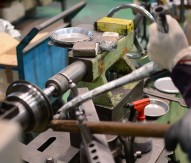
‘Pick and mix’ smart materials developed for robotics
Researchers from the UK’s University of Cambridge have developed a simple ‘recipe’ for combining multiple materials with single functions into a single material with multiple functions: movement, recall of movement, and sensing.
The research has been funded by the European Research Council and the materials could be used to make robotics far more efficient by replacing bulky devices with a single, smarter, life-like material. The new designer materials integrate the structure of two or more separate functions at the nanoscale, while keeping the individual materials physically separate. The gaps between the individual elements are so small that the final material is uniformly able to perform the functions of its component parts.
The materials are synthesised either in a one-pot reaction, with or without solvents, or through a series of sequential reactions, where the component parts are synthesised separately one by one, and sequentially infiltrated and cross-linked at the nanoscale.
Commenting, Dr Stoyan Smoukov, who led the research, said: “We’re used to thinking of synthetic materials as structural, rather than functional things. But we’re now entering a new era of multi-functional materials, which could be considered robots themselves, since we can program them to carry out a series of actions independently.”
In these new materials, the individual functions are integrated yet kept separate at the nanoscale. The researchers combined two different types of smart materials: an ionic electro-active polymer (i-EAP), which bends or swells with the application of voltage and is used in soft robotics, and a two-way shape memory polymer (SMP), which can be programmed to adopt and later recall specific shapes, in a type of muscle memory. The resulting combined material is what’s known as an interpenetrated network (IPN).
Due to the fact that the separate components are meshed at the nanoscale, there are unbroken paths within each component from one side of the material to the other, yet there are nanoscale boundaries between them as well. Such IPNs are highly resistant to cracks, making them very mechanically stable.
According to the researchers, utilising this technique may open up a whole new avenue for smart materials, since materials that have been designed for other, single, purposes could create a large variety of multifunctional combinations. The capabilities of these materials could make them very useful in robotics. Smoukov said these types of materials could even be considered robots on their own.
The results are published in the journal Advanced Materials.




